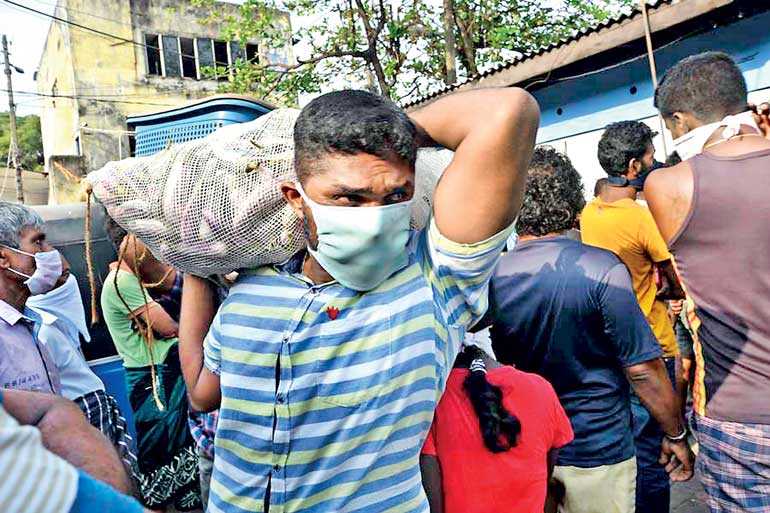Monday Jan 05, 2026
Monday Jan 05, 2026
Tuesday, 12 May 2020 00:00 - - {{hitsCtrl.values.hits}}

The response to COVID-19 and the resultant damage caused to food supply chains calls for a thorough re-examination of the entire agricultural system
– Pic by Shehan Gunasekara
Food supply chains are strained or broken, domestically as well as internationally. It is natural and necessary in such circumstances to think about food security. But it is important to think intelligently and in ways informed by evidence.
All rankings and indexes have flaws, either in the data that form their basis or in their design. But they provide a useful starting point for an evidence-based discussion. The Global Food Security Index comprises three components: affordability, availability, and quality and safety. A new component on natural resources and resilience was added in 2019.
The fact that Singapore, a city state with over 5 million people and no access to farmland and therefore to locally grown produce, is ranked first in the baseline index signals that this index is based on an approach to food security that goes beyond common sense. Singapore drops 11 places when natural resources and resiliency are accounted for. It is vulnerable to sea level rises, ocean eutrophication and food import dependency. But even in 11th place, it performs better than all South Asian countries.
I have been studying critical infrastructures for more than twenty years. Sri Lanka’s accession to the Tampere Convention on the Provision of Telecommunication Resources for Disaster Mitigation and Relief Operations and preparations for the Y2K problem were the immediate reasons. We have also been studying agricultural supply chains for over a decade.
Resilience-cost trade-off
There is always a trade-off between resilience and cost. If cost is of no concern, one can have extraordinary resilience, with 100% redundant facilities further backed up. Sometimes when the stakes are very high and the environment highly risky, one does have multiple back-ups. For example, in the worst days of the war when the LTTE was attacking Colombo and CEB engineers were striking at the drop of a hat, I was told about battery backup for mobile base stations, that were further backed up by diesel generators. But all this costs money.
It is the same with food security. One may believe that relying on locally produced potatoes reduces risks. But it is well known that the local production costs of potatoes are significantly higher than that of imported potatoes. Domestic producers are kept afloat by slapping special commodity levies on imported potatoes. What this means is that domestic consumers are paying more for inefficiently produced local potatoes and paying indirect taxes to the government for the imported potatoes they consume.
Protectionist duties add up, making food more expensive for all. As a result, the cost of labour is higher in Sri Lanka. Therefore, many industries that must compete globally are hobbled by high labour costs.
Sourcing from inefficient domestic producers does not necessarily reduce risk. Agriculture is inherently risky. Floods, drought, insects, and disease can devastate crops. Truly resilient supply chains would not rely on a single area (such as Welimada for potatoes), or even a single country. In the same way that one would not be totally dependent on, say, Viet Nam, for all the rice the country needs, it may not be a good idea to think of self-sufficiency in rice as an absolute policy objective.
In the face of COVID-19 and disruptions in global supply chains, Viet Nam has imposed some limits on rice exports which would give legitimate cause for concern among its customers. But on the other hand, relying totally on local production is also risky, as was seen in 2016-17 when drought reduced production to 1,474 MT from 2,903 MT in 2015-16.
So, the real answer for food security is not the simplistic striving for self-sufficiency, but the balancing of cost and risk management through diversifying sources and ensuring that supply chains are robust. Preventing the emergence of monopolies that control choke points is an important part of the response. It is these complex trade-offs and balances that the Global Food Security Index attempts to capture through the weighted combination of 34 different indicators.
Sri Lanka’s food security assessed
Sri Lanka was ranked 66th out of 113 countries in 2019. It was scored high in nutritional standards, change in average food costs, the proportion of population under global poverty line, food safety, food loss, urban absorption capacity, volatility of agricultural production, and access to financing for farmers. Its score was pulled down by factors such as public expenditure on agricultural R&D, per capita GDP based on purchasing power parity, protein quality and political stability (biggest decline between 2018 and 2019).
Sri Lanka’s overall score was slightly below the average, and quite a bit lower on quality and safety. It was ahead of its peers in South Asia, but behind peers such as Indonesia and the Philippines in South East Asia. India was ranked 72nd, with Pakistan (78th) and Nepal (79th) even lower. As usual, Sri Lanka was not too bad, but could be much better.
When the natural resources and resiliency is added to the mix, Sri Lanka falls back one place to 67th out of 113. The impact of resilience associated factors is greater in some countries. For example, Australia and New Zealand show wide swings. Australia, which is 12th in the baseline index, drops to 16th place when natural resources and resilience are factored in, whereas New Zealand overtakes Australia by advancing five places to 14th place.
Resilience that is sensitive to cost
The response to COVID-19 and the resultant damage caused to food supply chains calls for a thorough re-examination of the entire agricultural system. The fragility of the current system has been laid bare. But the response should be nuanced and based on a sober consideration of evidence, giving due regard to the need for value for money in food. Instead of prohibiting imports and imposing taxes on consumers to protect inefficient producers, the state should ensure that supply chains are resilient because they are diversified both domestically and internationally. The best way to do this is by preventing the monopolisation of links in supply chains.
Simplistic retreat to slogans such as self-sufficiency will not suffice. Sri Lanka has experience with those policies from the 1970s. Then they gave rise to black markets for the affluent and malnutrition for the poor. What was implemented in a much simpler time cannot be made to work in today’s more complex economy where consumer preferences cannot be satisfied by ration shops.